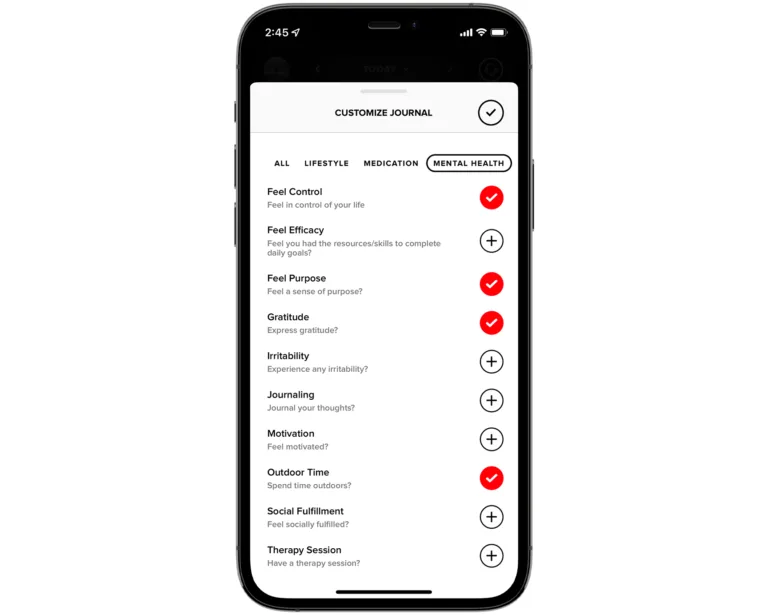Topics
- Article
- Mental Health
10 Mental Health Activities You Can Do at Home or Work

Working on mental health should be part of your daily routine. Here are 10 mental health activities you can do at work, at home, with the kids, and even in the car that can reduce stress and create a feeling of wellbeing.
Many of the strategies therapists recommend can be done on your own–or with friends–without anyone knowing that you’re practicing self-care. Here’s a list of mental health activities recommended by counselors that you can do at home, at work, in the car, or wherever you may be.
Visualization
Some of the world’s greatest athletes use visualization to see themselves where they want to be. NFL MVP and Super Bowl champion Patrick Mahomes told the WHOOP Podcast that uses the technique to picture plays and winning games.
“If you watch me before a game, 3 or 4 hours before a game, I’m just walking the field and just watching and visualizing the play happening and throwing the ball to [Travis] Kelce…. [I’m] visualizing the success. Visualizing going out there and winning the championships and winning the Super Bowl. [I’m able] to embrace those moments when I’m in them because I’ve seen it happen before.”
Visualization is a technique that uses your imagination to experience a desired outcome. It works by making you refocus your thoughts from the things you’re worrying about to what you want to happen. Athletes use it to increase confidence and decrease anxiety before a game or a race. You can use it to become more relaxed, confident, and motivated when you’re feeling stressed about a situation–for example, a project at work. In this case, you can imagine having completed the work project successfully and your boss and colleagues are thrilled with the outcome.
There are many techniques for visualization that work for different circumstances. If you have trouble sleeping, it may help to picture yourself lying on a serene beach with the hot sun beating down on you, white sand between your toes, and gentle waves lapping onto the shore nearby.
READ MORE: How Does Stress Affect HRV and Heart Rate?
Heading To the Gym
Exercise releases chemical messengers that make you feel great! Dopamine, noradrenaline, serotonin, and endorphins are all chemicals that help us thrive mentally. They balance memory, cognitive function, and emotions, relieve pain and anxiety, and regulate your circadian rhythm. Whatever workout or spot you choose, physical activities that get you moving and increase your heart rate will also benefit your mental health.
Mental Health Activities at Work
Work can be demanding on our mental health. In 2021, Gallup research found 57% of US and Canadian workers reported feeling stressed on a daily basis, compared to 43% of people who felt that way globally. The rates were significantly higher for women working in the US and Canada where 62% of working women reported daily stress. These rates reflect the impact of gendered expectations in the household and childcare, and women’s higher representation in low-wage jobs during the pandemic. While there are things companies can do to support their employees' life/work balance, there are actions you can take at work to support your own mental health and relieve anxiety.
Going For a Walk
You probably can’t get up and leave a meeting and expect to still have a job, but walking during your lunch break may help you feel better able to meet that tight deadline. Walking can improve your mood, sleep quality, and reduce stress. It also reduces tiredness that affects mental alertness, so a mid-day walk may make you feel active in the afternoon. Walking gives you time to think (you can practice visualization while you walk), and it boosts your mood by increasing your heart rate and circulation to the brain and body. If you invite your work friends to walk with you during lunch you’ll get the benefits of walking and social interaction, which can help ward off negative thoughts and improve self-esteem.
Deep Breathing
Similar to visualization, deep breathing relaxes your body and alleviates anxiety. Deep breathing also goes by the terms paced breathing, belly breathing, and abdominal breathing, and involves engaging your diaphragm muscles in each breath. Chest breathing, which is how most of us breathe, limits the diaphragm’s range of motion and restricts oxygen from the lowest parts of your lungs. Consequently, you may feel short of breath, anxious, or tense. Whether you’re typing at a desk or driving a truck, you may not realize your breath is coming short and shallow. Deep breathing usually takes a conscious effort to open your breathing passages, expand your belly, and pull air into the lowest parts of your lungs. There are many approaches to deep breathing, and several come from yoga traditions. As little as 1 minute of diaphragmatic breathing a few times per day has been shown to have a beneficial effect on the cardiopulmonary system and activate your parasympathetic nervous system. One of the easiest deep breathing techniques is box breathing:
- Breathe in through your nose, counting to 4 slowly and expand your belly to pull it deeper into your lungs.
- Hold your breath for 4 seconds.
- Slowly exhale through your nose for 4 seconds.
- Hold your breath again for 4 seconds.
- Repeat steps 1-4 for at least 1 minute.
Singing In the Car It sounds silly, but singing in the car is a great way to relieve tension after a hard day at work. Whether you prefer rap, K-pop, or metal, singing along to your favorite songs releases endorphins, diminishing anxiety. Bryan Johnson, entrepreneur and CEO of Kernel says he sings before going to bed. “I find that when I sing before I go to bed, my HRV improves,” he said. Singing activates the vagus nerve, which is basically your personal stress release button. Increasing vagal tone is one of the easiest ways to improve your overall wellness quickly.
Mental Health for the Family
When you choose to positively deal with stressful thoughts the entire family can benefit; not just from your improved mood and ability to cope, but also from taking part in activities with you. Spending time with your kids reduces everyone’s anxieties and may improve family relationships. Here are a few things that can support the entire family’s mental health: Going Outside Taking the kids for a walk, whether it’s around the block or on a hike, can reduce your anxiety and your kids’ chances of developing depression later in life. It will also improve their sleep patterns. Gardening Even growing a small patio garden improves focus and concentration, and connects the entire family to nature. Exposure to plants and green space lowers heart rate and muscle tension. According to one Japanese study, simply looking at plants also reduces anger and sadness Coloring Coloring is not just for kids. There are dozens of coloring books on the market designed for adults. Coloring and doodling can induce a meditative state as you focus on your present creativity. It improves your motor skills and focus, and reduces anxiety. Reading Reading books (rather than a screen) lowers your heart rate as effectively as yoga. Reading before bed is one technique to fall asleep faster, have better sleep, and increased recovery the next day. Reading to your kids is a relaxing activity that many parents choose to do as part of their bedtime routine. Reading about others’ experiences teaches kids how to handle emotions and empathy, builds vocabulary, and can reinforce your familial bond.
Track Your Mental Health with the WHOOP Journal
It’s not easy to monitor your mental health while you're trying to live your life. We’re often too busy to realize we’re feeling more stressed than normal, or that we’ve been snapping at our family and friends. The WHOOP Journal gives you an opportunity to note some of the mental health activities listed above and how you’re feeling every day. You can also track specific mental health actions like your emotional state, energy level, feeling purpose or gratitude, or a therapy session. At the end of each month you can review your Monthly Performance Assessment to see how your tracked activities affect your daily recovery.

You can track a number of mental health activities in the WHOOP Journal and learn how each impacts your sleep and recovery.